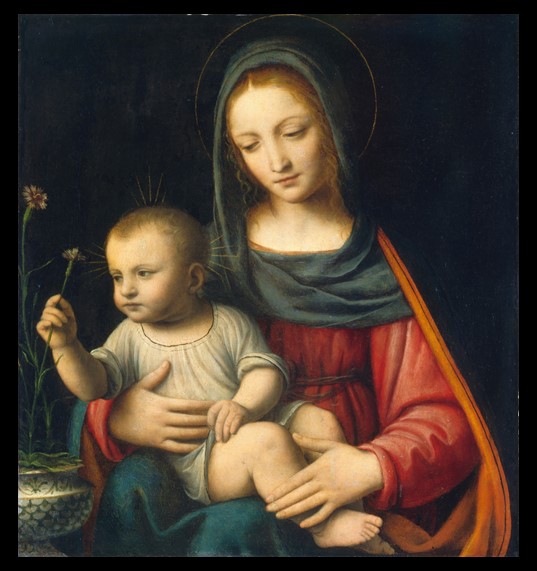
The Madonna of the Carnation, c. 1515, Oil on Panel, 43.8 x 40.3 cm, The National Gallery, Washington DC, USA https://www.nga.gov/collection/art-object-page.293.html
In Bernardino Luini’s the Madonna of the Carnation, the humble carnation flower plays a significant symbolic role, quietly enhancing the tender connection between mother and child. Painted during the Renaissance, this work captures the Jesus holding a carnation, a bloom historically associated with love, purity, and spiritual devotion. The carnation’s presence in Christian iconography extends beyond mere decoration; it reflects the deep, enduring love between Mary and Christ. Known for its resilience and modest beauty, the carnation was often used in religious art to symbolize faith and divine love, aligning beautifully with Mary’s role as a symbol of compassion and steadfast devotion. Through Luini’s detailed rendering, this simple flower transforms into a powerful emblem, inviting viewers to see carnations as more than just vibrant blooms but as timeless representations of love and spiritual purity.
As we embark on our journey through 2025, we’ll celebrate each month’s arrival with a flower, beautifully depicted in an artwork that captures its essence, symbolism, and historical significance. We’ll delve into the stories behind the chosen flower, exploring how it has inspired artists throughout the ages, expressed profound emotions, and represented the spirit of its season. This initiative is more than just a tribute to flowers; it serves as a personal invitation to pause each month and appreciate the harmonious relationship between nature and art. Join us as we uncover how artists have woven the language of flowers into their work, using them to convey themes of love, purity, resilience, and more, allowing us to experience the beauty of each month in a fresh and vibrant way.
With a rich history dating back over two millennia, carnations are imbued with deep meaning and symbolism, making them a beloved choice for various celebrations. As the flower of the month for January, their delicate fragrance and vibrant spectrum of colours not only captivate the senses but also ensure that carnations remain a cherished floral selection for events such as weddings and birthdays.
Carnations, one of the oldest cultivated flowers in the world, have a fascinating origin that dates back to Ancient Greek and Roman times, where they were first documented by Theophrastus, an early botanist. Primarily grown in Europe and Asia, these beloved blooms were celebrated for their use in art, decor, wreaths, and perfumes, while also offering notable health benefits; for instance, brewing carnation tea was a common remedy for stress, boosting energy levels and alleviating ailments like stomach aches and fevers.
The name ‘carnation’ has various theories behind it, with some believing it stems from the word ‘coronation’ due to its presence in Greek ceremonial crowns, while others suggest it derives from the Latin word ‘carnis,’ meaning flesh, as early carnations were predominantly pink. However, the scientific name, Dianthus caryophyllus, is rooted in Greek mythology, with ‘dianthus coming from ‘dios, meaning Zeus, and ‘anthos,’ meaning flower, further solidifying carnations’ status as the ‘flower of the gods.’
Carnations carry rich symbolism across various cultures, embodying deep meanings that make them a cherished flower for many occasions. They represent devotion, making them an ideal choice for weddings, as they signify the commitment and loyalty shared between partners; this symbolism has been reflected in the works of Renaissance artists who often depicted carnations in engagement scenes. Additionally, carnations symbolize love, whether familial, romantic, or platonic, making them a thoughtful gift for celebrations like birthdays, or anniversaries. Their unique shape and vibrant colours also convey a sense of distinction, allowing them to stand out beautifully in any bouquet. Lastly, the captivating appearance of carnations evokes a sense of fascination, having inspired poets, artists, and musicians throughout history; receiving a bouquet of these delightful blooms suggests that the giver finds you equally intriguing.
Bernardino Luini was an Italian Renaissance painter, renowned for his refined, graceful works that reflected the influence of Leonardo da Vinci, whom he likely studied under. Born in Dumenza near Lake Maggiore, Luini moved to Milan, where he spent much of his career and created many religious frescoes and altarpieces. His style is characterized by delicate, serene expressions and a soft, harmonious colour palette, with works often portraying religious subjects imbued with a gentle spirituality. Luini’s frescoes in Milan’s Church of San Maurizio al Monastero Maggiore are among his most celebrated works, displaying his mastery of composition and his distinctively soft, Leonardesque figures. Though he was less famous than some of his contemporaries, Luini’s works have gained appreciation for their subtle beauty and enduring charm.
Bernardino Luini’s Madonna of the Carnation depicts the Virgin Mary with the infant Christ seated on her lap, tenderly reaching for a carnation in a nearby pot. Though it appears a simple, everyday gesture, the carnation in Renaissance art held deep symbolism—often representing the Crucifixion or Mary’s pure love. In this delicate moment, Luini subtly hints at Christ’s future sacrifice, while Mary’s thoughtful, almost wistful gaze reflects her awareness of this foreshadowed path. Luini’s painting resonates with the influence of Leonardo da Vinci, evident in its soft forms, rich chiaroscuro, and the tender expressiveness of the figures. The dark background and the gentle play of light and shadow create an intimate, almost ethereal atmosphere, capturing a poignant connection between mother and child.
For a PowerPoint presentation of Bernardino Luini’s oeuvre, please… Check HERE!
Bibliography: https://www.bloomandwild.com/the-blog/the-symbolism-and-colour-meaning-of-carnations and https://www.nga.gov/collection/art-object-page.293.html